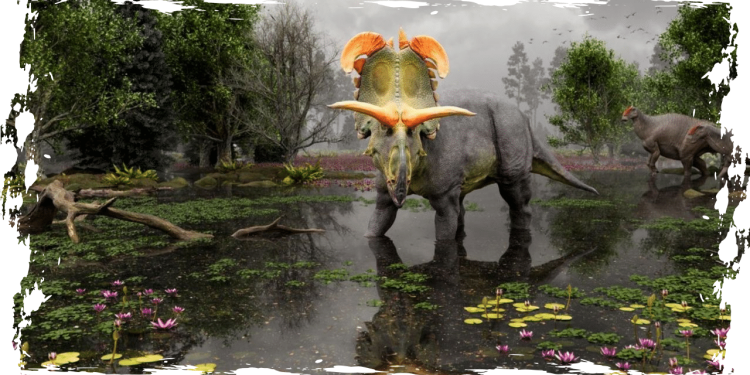On Thursday, American scientists made an announcement about the discovery of a new species of horned dinosaur. This dinosaur was the largest centrosaurine ever found in North America, weighing 11,000 pounds and measuring 22 feet in length. It roamed the swamps of what is now the badlands of Montana during the late Cretaceous period, approximately 78 million years ago.
In a recent discovery, a new dinosaur has been identified and named as Lokiceratops rangiformis by Joseph Sertich, a faculty member at Colorado State University, and Mark Loewen, a professor at Utah University. The dinosaur is distinguished by its extravagant curved blade-like horns on the back of its “frill” and an asymmetrical horn, which is similar to the antlers of caribou, as stated in a news release by Colorado State University.
A recent discovery, which was published in the scientific journal PeerJ after undergoing peer-review, has been named after the Norse god Loki. The creature, which is a descendant of the Triceratops, has a human-like appearance and horns, and is referred to as “Loki’s horned face that looks like a caribou.”
According to Scott Loewen, a paleontologist at the Natural History Museum of Utah in Salt Lake City, “We decided to give the dinosaur a Norse god name since it now resides permanently in Denmark. And when you look at it, doesn’t it appear to resemble Loki with its curved blades?”
During the replica’s public display at the museum, co-author and paleontologist from the Smithsonian Tropical Research Institute, Sertich, expressed his satisfaction, saying, “This is a story with a happy ending. Instead of ending up in someone’s private collection, it will now be preserved in a museum for people to study and appreciate for generations to come.”
Both men serve as scientific consultants to the Museum of Evolution on the Danish island of Lolland, located south of Copenhagen, where the original is permanently on display.
Using bone fragments that were no larger than dinner plates, Sertich and Loewen were able to reconstruct the head and frill/horns array. These fragments were discovered in northern Montana, just south of the Canadian border, back in 2019.
After assembling the skull, it became apparent that a new dinosaur species had been discovered – the biggest centrosaurine ever found in North America.
This horned dinosaur boasts the largest frill horns on record among its kind, yet it stands out from other centrosaurines due to its absence of a nose horn.
According to Sertich, this particular dinosaur sets a new standard for unusual ceratopsian headgear as it boasts the largest frill horns ever observed in a ceratopsian.
According to experts, the skull ornaments play a crucial role in understanding the diversity of horned dinosaurs. They believe that the showy displays on these creatures were a result of evolutionary selection, which played a significant role in the vast array of Cretaceous ecosystems.
The Lokicertatops may look intimidating with its elaborate headgear, but in reality, it was a peaceful herbivore, much like the Triceratops. Its impressive appearance was purely for display purposes and had no relation to hunting or preying on other creatures.
Sertich drew a comparison between dinosaur horns and feathers on birds, highlighting the unique color and design evolution that sets apart each species from similar ones.
According to him, the horns on dinosaurs had a similar purpose to the displays that birds use for mate selection or species recognition.
According to research, Lokiceratops and four other dinosaur species were discovered in the same rock layer, indicating that they all existed together 78 million years ago. These creatures roamed the swamps and coastal plains along the eastern shore of a then-sea that ran down the middle of the continent. Interestingly, three of the species were closely related and only found in the same region.
According to Sertich, it is extremely rare to find five of these animals living together. He likened the situation to what one might see on the plains of East Africa today with various horned ungulates co-existing in the same area.
Researchers have found that the discovery of Loki proves that the three species appeared in a limited geographical area within a relatively short period. This is a phenomenon that is often observed among birds living in isolated habitats or on islands. In contrast, mammals such as elk are found across a wide range in the western United States.
By the end of the Cretaceous era, there were only two species of horned dinosaurs found across Canada to Mexico. It is believed that these regional differences were eliminated due to a uniform climate replacing the previous regional differences in climatic conditions. These findings were presented by Sertich.
During the Cretaceous period, the horned dinosaurs and the entire dinosaur era came to an end due to the Chicxulub impactor. This occurred when a 7-mile-wide asteroid crashed into the northern coast of what is currently the Yucatan Peninsula in Mexico, at a speed of 45,000 miles-per-hour.
According to the research, the genealogy of horned dinosaurs is more extensive than ever before, showcasing a greater diversity among the creatures than what was initially believed.
According to Loewen, Lokiceratops sheds light on the fact that we have barely begun to explore the vast diversity and interconnections among horned dinosaurs.










